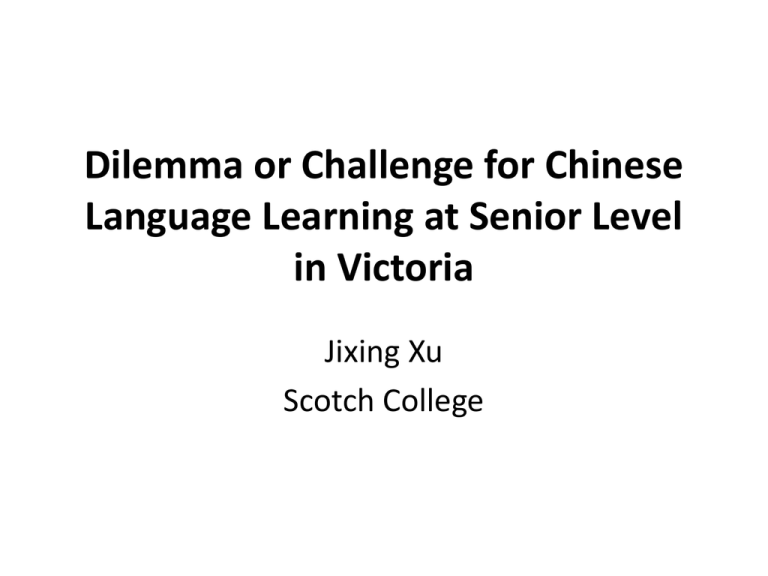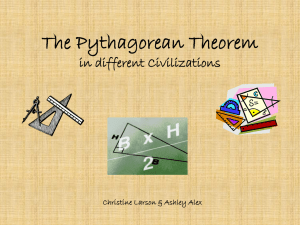2.30pm-Xu-2011-Darwin-Powerpoint
advertisement

Dilemma or Challenge for Chinese Language Learning at Senior Level in Victoria Jixing Xu Scotch College • Introduction: • In Victoria, Mandarin Chinese language teaching is on the edge of becoming a community learning language • a. a high dropout rate of non-background students of Chinese at senior level; • Requirement of VCE Chinese proficiency is well beyond nonbackground students’ ability • Can’t compete with background students of Chinese • Curriculum and assessment for Chinese SL are inadequate • Eligibility policy needs to be changed • 1. Issue of Current VCE Chinese • Chinese programs started in the late ’50s and early ‘60s in Victoria • The real impetus during the Hawke government in the late ‘80s and early ‘90s, through NALSAS • VCE formally started in 1992, one group of Chinese students • Two groups in VCE Chinese started in 2001 • Three groups in VCE Chinese started in 2004, only Chinese has three cohorts of VCE Year 12 students Table 1: VCE Year 11 Chinese Enrolment 2002-2010 Year\Group First Language (CFL) Second Language (CSL) 2002 2004 2006 2008 2010 635 936 1006 1147 1,275 653 540 470 975 758 Second Language Advanced (CSLA) 320 380 355 362 Total 1,288 1,796 1,856 2,477 2,395 Table 2: VCE Year 12 Chinese Enrolment 2002-2010 Year\ Group 2002 2004 2006 2008 2010 First Second Second Language Language Language (CFL) (CSL) Advanced (CSLA) 1480 580 1868 719 318 1489 741 376 1722 697 341 1879 952 352 Total 2,060 2,905 2,606 2,760 3,183 Table 3: Total VCE Chinese Enrolment in Year 11 & 12, 2002-2010 Year\ Group 2002 2004 2006 2008 2010 First Second Second Total Language Language Language (CFL) (CSL) Advanced (CSLA) 3,348 4,701 4,462 5,237 5,578 • Dr Jane Orton, 2008 Report • a. At Year 12 nationally, 3 per cent of students take Chinese, 94% of whom are first language speakers of Chinese • Non-background students are in the same class with native speakers of Chinese • 94% students drop out before Year 12 • Reasons for drop out: • a. native speakers overwhelm in assessment in class • b. lack of success in developing proficiency due to insufficient time of instruction and teaching of certain aspects • c. unsupportive environment • 2. Eligibility Policy for Chinese • Chinese First Language: for students of native or near-native ability who have received more than 7 years of formal schooling through the medium of Chinese in a country or region (including China, Taiwan, Hong Kong and Macao) where Chinese is an official or mother tongue language. • Chinese Second Language Advanced: for students who have had no more than 7 years of formal education through the medium of Chinese in a country or region where Chinese is an official or mother tongue language, and where the highest level of education attained in a school where Chinese is the medium of instruction is no greater than the equivalent of Year 7 in a Victorian school. • Chinese Second Language: for students who have had no more than 12 months of education in a school where Chinese is the medium of instruction, or who have had less than 3 years’ residence in any of the VCAA nominated countries or regions. • Note: The time periods referred to in the above criteria are to be counted cumulatively since the time of the student’s birth. As the formal education commencement age for a Victorian student is five years of age, all applicants will be deemed to have commenced formal education by the end of their fifth year of age, regardless of the setting. • Based on these categories, Australian Curriculum, Assessment and Reporting Authority (ACARA) suggested renaming these three cohorts as: • First Language Learners: home speakers from the target language society who have taken primary and early secondary schooling in the target language; they have had their primary socialisation in the language as well as literacy development in that language; • Second Language Learners: classroom learners who are introduced to the target language at school; • Heritage Learners: home speakers who have been educated in Australia—they have existing knowledge of the target language to varying degrees (for example, vocabulary phonological accuracy, fluency and readiness to use the language) and have a base ready for literacy development. (see ACARA: Language-Initial Advice Paper, 2010, p.17) • Debate and argument: • Dr Orton: university incentives (ANU Japanese program) • Paul Carolan: Second Language Learners with less than 10 weeks in China • 3. Curriculum and Assessment • Two VCE Chinese study designs: first language and combined one for second language and second language advanced • Not much change for first language study design since 2001 • Main changes for second language and second language advanced study design: • a. introduction of translation • b. significant reduction of the weight of listening in both coursework and end-of-year examinations • Assessment: the relationship between the learning time allocation and assessment • Needs 4-5 times of hours more than learning an European language • Requirement of some 500 characters by Year 12 • Format and content of assessment





